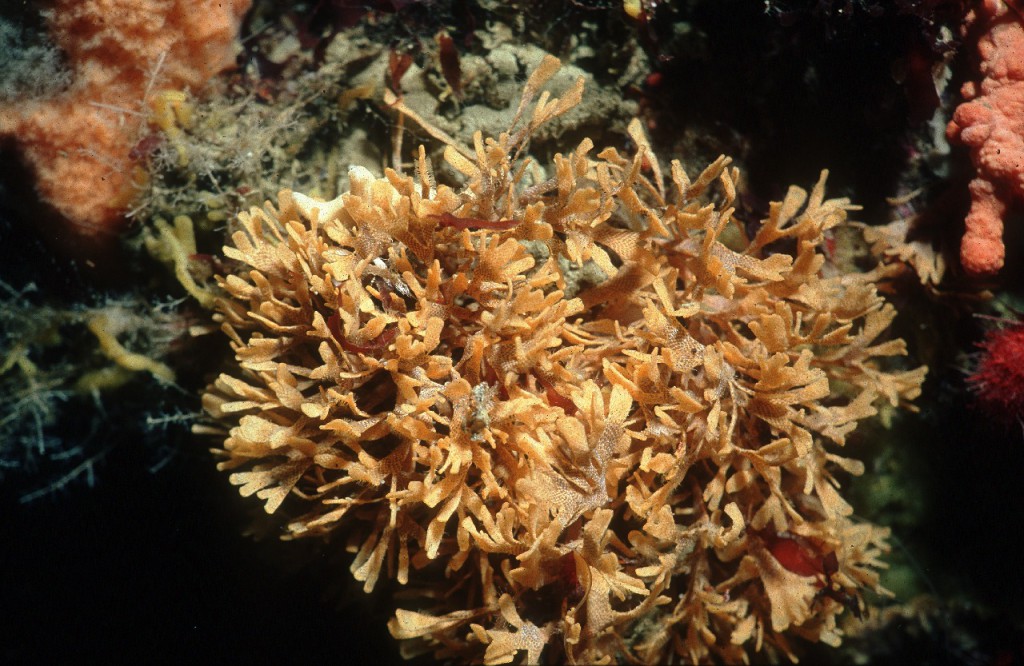Captain Scott’s century-old collections suggest marine life is capturing more carbon
Tiny Antarctic marine creatures collected 100 years ago by Antarctic explorer Captain Robert Falcon Scott give new clues about polar environmental change. By comparing present-day bryozoans – a sea-bed filter-feeding animal that looks like branching twigs – with specimens from Scott’s expeditions scientists have found the first conclusive evidence of increased carbon uptake and storage by Antarctic marine life.

This image is associated with the 2005-2010 BAS science programme: BIOFLAME – Biodiversity, Function, Limits and Adaptation from Molecules to Ecosystems.
Reporting this week in the journal Current Biology an international team of scientists explain how they examined annual growth bands in skeletons of specimens of bryozoans (Cellarinella nutti) collected from Antarctica’s Ross Sea during the Census of Antarctic Marine Life. When compared with museum collections in the UK, US and New Zealand – including specimens from Scott’s expeditions – they found that since 1990 bryozoans grew more rapidly than at any time before. The most likely explanation is greater availability of food (phytoplankton). The findings suggest that this new growth is an important mechanism for transferring carbon into the sea bed.
Lead author, Dr Dave Barnes, of the British Antarctic Survey (BAS) says,
“For the first time we’ve been able to use the longest record of animal growth as evidence of rapid recent change to life on the seabed. Scott’s biological collections are considerable in quality and quantity and will continue to become even more valuable for determining how life responds to change across time. Few biological studies in Antarctica go back more than 30 years, so these data are invaluable and highlight the importance of long-term monitoring.”
The spurt in growth means that animals reach the size earlier at which ocean currents snap them off. As the animals topple over they bury carbon, therefore increasing the seabed’s potential as a carbon sink.
ENDS
Issued by the BAS Press Office:
Athena Dinar, Tel: +44 (0)1223 221414; mobile: 07736 921693; email: amdi@bas.ac.uk
Audrey Stevens, Tel: +44 (0)1223 221230; email: auev@bas.ac.uk
Scientist contact details:
Dr David Barnes, Tel: +44 (0)1223 221613; Mobile: 07736 921 693; email: dkab@bas.ac.uk
Stunning broadcast-quality footage and stills of Antarctica, along with a copy of the Current Biology paper are available at: ftp://ftp.nerc-bas.ac.uk/pub/photo/Scott_Bryozoans
Images used should be credited to British Antarctic Survey
Scott’s collections help reveal accelerating marine life growth in Antarcticaby David A. Barnes, Piotr Kuklinski, Jennifer A. Jackson, Geoff W. Keel, Simon A. Morley and Judith E. Winston is published in Current Biology on 22 February 2011.
Notes for editors:
Bryozoans (aquatic animals sometimes referred to as moss animals) feed on micro-organisms suspended in the water column. Their larvae are benthic and short-lived but this is the dispersal stage – as adults they anchor themselves to the seabed. Many of the 500 species around Antarctica are restricted to shallows and particular continental shelves.These tiny animals feed on phytoplankton (small marine plants) that need carbon dioxide in order to grow and reproduce. The carbon in the phytoplankton is then taken up by the bryozoans and is used to form its skeleton and tissues.
Dr Barnes and his colleagues studied over 800 specimens collected from the Ross Sea area of Antarctica since 1890. Recent collections of bryozoans are from UK and US scientific ship cruises in Antarctica around the Ross Sea. Older specimens were from Scott’s collections during the National Antarctic and British Antarctic expeditions (1901 & 1913); the Discovery expeditions (1936) and later research cruises of the 1950-1970s.
Census of Antarctic Marine Life (CAML) is the International Polar Year 2007-08 component of the Census of Marine Life – a global network of researchers in more than 80 nations engaged in a 10-year scientific initiative to assess and explain the diversity, distribution, and abundance of life in the oceans. The world’s first comprehensive Census of Marine Life – past, present, and future – will be released in 2010.
Captain Robert Falcon Scott was one of the great polar pioneers and led the National Antarctic Expedition and British Antarctic Expeditions at the turn of the last century. His most famous journey was to reach the South Pole, but a team led by the Norwegian explorer Amundsen beat them to it. Scott’s team died in 1912 on the journey back to his food depots and so his exploits are often not associated with success. What is not so well known is that his voyages were first and foremost scientific ones and the collections of material and information they made were impressive even by today’s standards. Despite making his goal of reaching the South Pole much harder he refused to sacrifice any scientific effort or quality.
British Antarctic Survey (BAS), a component of the Natural Environment Research Council, delivers world-leading interdisciplinary research in the Polar Regions. Its skilled science and support staff based in Cambridge, Antarctica and the Arctic, work together to deliver research that underpins a productive economy and contributes to a sustainable world. Its numerous national and international collaborations, leadership role in Antarctic affairs and excellent infrastructure help ensure that the UK maintains a world leading position. BAS has over 450 staff and operates five research stations, two Royal Research Ships and five aircraft in and around Antarctica. www.antarctica.ac.uk
